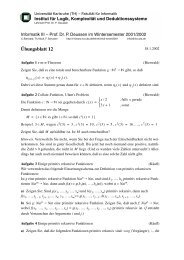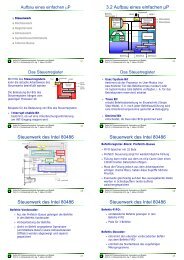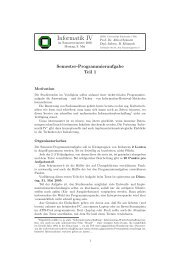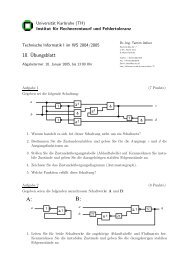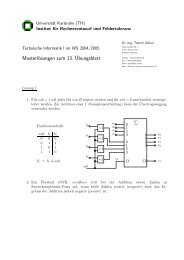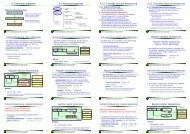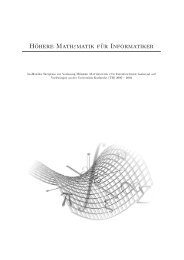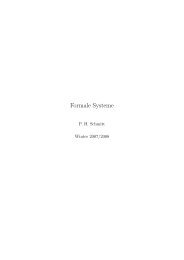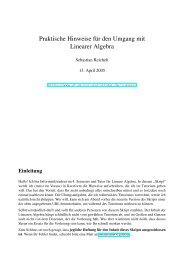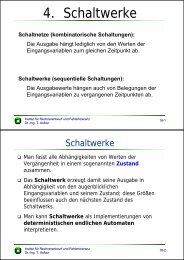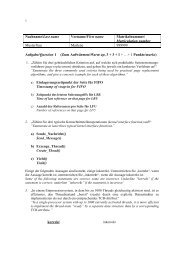Lösung: System Architektur Klausur 25. März 2008 - next-internet.com
Lösung: System Architektur Klausur 25. März 2008 - next-internet.com
Lösung: System Architektur Klausur 25. März 2008 - next-internet.com
You also want an ePaper? Increase the reach of your titles
YUMPU automatically turns print PDFs into web optimized ePapers that Google loves.
<strong>Lösung</strong>: <strong>System</strong> <strong>Architektur</strong> <strong>Klausur</strong> <strong>25.</strong> <strong>März</strong> <strong>2008</strong><br />
1<br />
Aufgabe 1 / Question 1 (Zum Aufwärmen/Warm up, 2 + 2 + 1 + 1 + 6 Punkte/marks)<br />
1. „An welchen vier <strong>System</strong>zielen (system objectives) sind Nutzer eines Dienstleistungsrechensystems<br />
am meisten interessiert?“<br />
“For users of a central <strong>com</strong>puter service system, what are the four most interesting system<br />
objectives?”<br />
Customizability Performance<br />
Quality of Service Security & Protection<br />
2. „Zählen Sie zwei Möglichkeiten auf, wie man Parameter eines <strong>System</strong>aufrufs (system call)<br />
aus der Anwenderebene in die geschützte Kernebene übergeben kann!“<br />
“Enumerate two possibilities how to hand over parameters of a system call from application<br />
level to the protected kernel level.”<br />
Register User-Stack<br />
3. „Wollte man Verklemmungsverhinderung (deadlock prevention) implementieren, welche<br />
der vier notwendigen Verklemmungsbedingungen würde man dann angreifen? “<br />
“In case you want to implement deadlock prevention, which of the four necessary deadlock<br />
conditions would you attack?”<br />
No-Circular-Wait-Condition<br />
Einige der folgenden Aussagen sind korrekt, einige sind inkorrekt. Unterstreichen Sie „korrekt“,<br />
wenn die Aussage korrekt ist, unterstreichen Sie „inkorrekt“, wenn die Aussage inkorrekt ist.<br />
Some of the following statements are correct, some are incorrect. Underline “korrekt” if the<br />
statement is correct; underline “inkorrekt” if the statement is incorrect.<br />
4. „Beim Halbierungsverfahren (buddy system) kann es sowohl zum internen (internal) als<br />
auch zum externen (external) Verschnitt (fragmentation) kommen.“<br />
“In a buddy system there might be internal as well as external fragmentation.”<br />
korrekt inkorrekt<br />
5. „„Der virtuelle Adressraum eines IA64 Rechners ist größer als der korrespondierende<br />
physische Adressraum.“<br />
“The virtual address space of an IA64 machine is larger than the corresponding physical<br />
address space.”<br />
korrekt inkorrekt
2<br />
6. „Das Auffinden eines bestimmten Datensatzes (record) in einer sehr großen B*-Baumindexierten<br />
sequentiellen Datei ist optimal bezüglich der Zahl der Plattenzugriffe.“<br />
“Looking up a specific record in a huge B*-tree indexed sequential file is optimal with<br />
respect to the number of disk accesses.”<br />
korrekt inkorrekt<br />
7. „Der trap oder int Befehl, mit dessen Hilfe man bei einem <strong>System</strong>aufruf (system call)<br />
vom Nutzermodus in den Kernmodus gelangen kann, ist ein normaler, d.h. nicht<br />
privilegierter Prozessorbefehl.“<br />
“The trap or int instruction that can be used to switch from user mode to kernel mode<br />
during a system call is a normal, i.e. non-privileged processor instruction.”<br />
korrekt inkorrekt<br />
8. „In einem Dateisystem kann es keinen externen Verschnitt (external fragmentation) geben,<br />
da alle Speichereinheiten, d.h. die Plattenblöcke, die gleiche Größe haben.“<br />
“There can be no external fragmentation in a file system, because all storage units, i.e. the<br />
disk blocks, have the same size.”<br />
korrekt inkorrekt<br />
9. „Damit ein reiner Anwenderthread (PULT) einen anderen PULT der gleichen Task<br />
aufwecken kann, muss die umgebende Task im Zustand rechnend sein.“<br />
“To allow a pure user-lever thread (PULT) to wakeup another PULT of the same task, its<br />
surrounding task must be in the state running.”<br />
korrekt inkorrekt<br />
10. „Ein fairer PULT-Scheduler garantiert, dass in einem Mehrprogrammsystem (multi<br />
programming) jede Anwendung einen fairen CPU-Anteil erhält.“<br />
“A fair PULT-scheduler guarantees that each application gets a fair share of the CPU in<br />
a multiprogramming system.”<br />
korrekt inkorrekt<br />
Aufgabe 2 / Question 2 (1 + 3 +2 + 4 + 2 Punkte/marks)<br />
1. „Welches Prinzip der <strong>System</strong>strukturierung hat Dijkstra benutzt, um sein THE <strong>System</strong> zu<br />
entwerfen?“<br />
“Which principle of structuring systems did Dijkstra use to design his THE system?”<br />
Layered Model (Schichtenmodell)
3<br />
2. „Beschreiben Sie die wesentlichen Eigenschaften einer komponenten-basierten oder<br />
server-orientierten <strong>System</strong>architektur!“<br />
“Describe the fundamental characteristics of a <strong>com</strong>ponent based or server oriented system<br />
architecture.”<br />
A server-oriented architecture (SOA) is more robust, because a failure within<br />
one server only crashes this server, all other services can still survive, no<br />
unwanted side effects of a buggy server. In a macro-kernel the same failure<br />
might lead to a system crash.<br />
A SOA needs fast IPC, otherwise it’s too slow <strong>com</strong>pared to a macro-kernel<br />
based system.<br />
A SOA can be extended quite easily, just add a new server, that’s it.<br />
A SOA is easier to maintain due to less <strong>com</strong>plexity per server.<br />
3. „Erklären Sie, warum das Parallelisieren von Anwendungen (applications) auch auf einem<br />
Einprozessorsystem Vorteile bringen kann!“<br />
“Explain why parallelizing applications can be advantageous even on a single-processor.”<br />
When some of the KLTs invoke synchronous I/O from time to time or must wait<br />
for results, some other KLT is calculating, the kernel scheduler could switch to a<br />
KLT of the same task thus speeding up the turnaround time of the whole task.<br />
4. „Diskutieren Sie die zwei Aspekte, weswegen man virtuelle Maschinen bei der<br />
Entwicklung von Betriebssystemen einsetzen kann.“<br />
“Discuss the two aspects for which virtual machines can be used in OS development.”<br />
Virtual machines support the possibility to develop and test new system<br />
features, while the users still work with the old ones. Booting the new system is<br />
faster, and no additional hardware is needed.<br />
Virtual machines also support specific OS versions that might be the only port<br />
of a specific application-system or a data base. With virtualization, each legacy<br />
application can be run on top of its preferred operating system in a virtual<br />
machine, while current applications can be executed on an up-to-date version or<br />
OS in another virtual machine—all on the same hardware. This approach<br />
allows the OS developers to add/change/improve the OS API while the<br />
administrators can still run the software requested by their users.<br />
5. „Unterstreichen Sie diejenigen der unten angegebenen Makrokern-Datentypen, die nicht<br />
Bestandteil eines modernen Mikrokerns sind.“<br />
“Underline those of the below mentioned macro-kernel data types that are not part of a<br />
modern micro-kernel.”<br />
PULT control block Bitmap for free-/allocated disk blocks<br />
KLT Kernel stack KLT control block
4<br />
Aufgabe 3 / Question 2 (2 + 2 + 2 + 6 Punkte/marks)<br />
1. „Erläutern Sie den Unterschied zwischen einer kritischen Region (critical region) und<br />
einem kritischen Abschnitt (critical section)!“<br />
“Explain the difference between a critical region and a critical section.”<br />
A critical section CS is a code path within a parallel application (either part of a<br />
thread or a process) that has to be executed exclusively concerning all other<br />
related CSs of the same critical region. (Typically a CS code is accesses <strong>com</strong>mon<br />
data -either global data of a task or part of a shared memory object-, or uses an<br />
exclusive resource)<br />
A critical region consists of all related critical CSs within a parallel application.<br />
2. „Erklären Sie den Begriff „geschachtelter Monitor (nested monitor)“! Unter welchen<br />
Umständen kann es bei der Verwendung geschachtelter Monitore zu Verklemmungen<br />
(deadlocks) kommen?“<br />
“Explain the notion of a “nested monitor”! Under which circumstances can the use of nested<br />
monitors lead to a deadlock?”<br />
A nested monitor consists of at least two different software monitors, whereby<br />
we distinguish between an outer (or lower) and an inner (or higher) monitor.<br />
They are nested when inside a monitor function of the outer monitor another<br />
monitor function of the inner monitor is called.<br />
Deadlocks can arise when in a monitor function of the inner monitor a function<br />
of the outer monitor is called.<br />
3. „Beschreiben Sie die Eigenschaften, die eine gültige <strong>Lösung</strong> eines wechselseitigen<br />
Ausschlussproblems besitzen muss, damit sie die Portabilitätsanforderung erfüllt.“<br />
„Describe the characteristics that a valid solution for a mutual exclusion problem must have<br />
in order to fulfill the requirement portability.”<br />
Solution must be valid independent of number of CPUs and of cheduling policy<br />
4. „Sie müssen ein 1:n-„AND“-Kanalobjekt (broadcast <strong>com</strong>munication channel) im Kern<br />
implementieren. Welche Gestaltungsparameter können Sie hierbei noch frei wählen?<br />
Diskutieren Sie deren Auswirkungen auf die Nutzung dieses Objekt durch KLTs!“<br />
“You must implement a 1:n-“AND”-broadcast <strong>com</strong>munication channel in the kernel. What<br />
design parameters can you still chose arbitrarily? Discuss their implications on the usage of<br />
this <strong>com</strong>munication object by KLTs.”<br />
Fixed design parameters:<br />
a) Indirect addressing<br />
b) Connectionless<br />
c) Data transfer must be via memory as long the messages are different in size.<br />
Data transfer can only be in registers if two constraints are met: 1. Short<br />
messages and 2. Synchronous send, whereby the sender is blocked until the<br />
last receiver has consumed the message. Using a kernel channel you must<br />
deal with copy-in and copy-out.
5<br />
Selectable design parameters:<br />
a) Synchronization: good choice asynchronous sender & synchronous receiver,<br />
but there is the danger of flooding the kernel. With a synchronous send a<br />
sender might be blocked until the latest receiver has called receive. However,<br />
you could also say, that the sender might proceed when the first receiver has<br />
consumed the message, or you can say that when x% of all attached receiver<br />
have consumed the message you will wakeup the “semi-synchronous” sender.<br />
b) Deterministic number of receivers, i.e. at run-time the number of attached<br />
receiver stays constant. But you can also allow dynamic attaching, but then<br />
you must solve the problem, how long a message should stay in messagequeue,<br />
if some attached receiver is blocked for a very long time. Furthermore<br />
you can chose, whether a receiver is allowed to consume the <strong>next</strong> message if a<br />
previous message is still in the message queue, because another lazy receiver<br />
has not yet done its job.<br />
c) Messages can be tagged thus enabling a selective broadcast, i.e. only receivers<br />
with the tag can receive the message, others have to wait for an appropriate<br />
message.<br />
Aufgabe 4 / Question 4 (4+ 2 + 2 + 4 Punkte/marks)<br />
1. „Zählen Sie jeweils zwei unterschiedliche Stellen in einem modernen Mikrokern bzw. in<br />
einem traditionellen Makrokern (aber nicht im Mikrokern) auf, an denen die Funktion<br />
Thread_Switch aufgerufen werden kann!“<br />
“Enumerate two different places in both kernel types, i.e. micro respectively macro kernel<br />
(but not in a micro kernel) where the function Thread_Switch can be called.”<br />
Mikrokern (micro kernel)<br />
send_message receive_message<br />
Makrokern (macro kernel)<br />
read_file allocate_resource<br />
2. „Weswegen muss ein <strong>System</strong>architekt in der Lage sein, temporär Unterbrechungen<br />
(interrupts) ausmaskieren können? Erklären Sie den allgemeinen Verwendungszweck und<br />
geben Sie dann noch ein ganz konkretes Fallbeispiel an!“<br />
“Why must a system architect be able to mask interrupts temporarily? Explain the general<br />
purpose and then give a specific example.”<br />
In the kernel there might be a very critical path (i.e. accessing the global ready<br />
queue) that should run exclusively, i.e. without any interruption. Another<br />
example is a semaphore, i.e. within a p-Operation testing the semaphore value<br />
you do not want to be interrupted by a time-slice interrupt, otherwise the<br />
semantics of an atomic p-operation is no longer valid.
6<br />
3. „Erklären Sie, welche Aktionen bei einem <strong>System</strong>aufruf (system call) direkt von der<br />
Hardware und welche von der Software ausgeführt werden.“<br />
“Explain what actions are executed directly by hardware respectively by the software during<br />
a system call.”<br />
HW does the mode switch including setting of kernel mode-bit & saving the user-level<br />
context either onto the current kernel-stack or into shadow registers<br />
Jump to the start address specified via the index of the “interrupt-vector table”<br />
SW extracts the necessary parameters from the user-stack or from shadow registers &<br />
calls the corresponding system call handler, masking out maskable interrupts.<br />
4. „Welche Metadaten gehören zu einer B*-Baum-indizierten sequentiellen Datei?“<br />
“Which meta data belong to a B*-tree-indexed sequential file?”<br />
Header of a doubled-linked list of all the leave nodes of the B*-tree enabling<br />
sequential access.<br />
Root of B*-tree enabling direct access via further inner nodes.<br />
Inner nodes containing the corresponding maximal index of the subtree<br />
respectively the leave node, i.e. the data container<br />
All other user and file related information, i.e. file owner, time of last modifying<br />
access, access rights etc.<br />
5. „Welche Einträge enthält sogar ein „leeres“ ext2-Verzeichnis?“<br />
“Which entries does even an “empty” ext2 directory contain?”<br />
. = current directory .. = parent directory<br />
Aufgabe 5 (2 + 2 + 2 + 2 + 2 + 2 Punkte)<br />
1. „Charakterisieren Sie das Speicherverfahren Slab-Allocator hinsichtlich vier orthogonaler<br />
Entwurfsparameter!“<br />
“Characterize the slab allocator according to four orthogonal design parameters.”<br />
No internal and no external fragmentation<br />
Size of memory object per slab is constant<br />
General allocation and release sequence<br />
Separated data structure to manage the slabs<br />
No (or very lazy) reunification, as long as the slab is used<br />
Allocation policy ~ last release first reused
7<br />
2. „Wie viele Seitenfehler (page faults) können auf einem CISC-Rechner während der<br />
Ausführung eines „Zwei Operanden Befehls“ auftreten? Begründen Sie Ihre Antwort!“<br />
“How many page faults on a CISC-machine can occur during the execution of a twooperand<br />
instruction? Explain your answer!”<br />
With no indirect addressed operands 4(6), because a CISC instruction might need two<br />
pages and each of the two operand might be on a separate page, (as well as each<br />
operand)<br />
3. „Angenommen in einem <strong>System</strong> mit transparenter Superseitenunterstützung tritt<br />
Speicherdruck auf. Wie kann man darauf reagieren?“<br />
“Suppose in a system with transparent support for super pages there will be memory<br />
pressure. How can you react?”<br />
You can always swap out a disturbing task, but you can also demote super<br />
pages, i.e. you chose the most promising super page and swap it out, if modified<br />
or just declare it no longer mapped and try to satisfy the current page fault,<br />
however only using smaller super page-frames or even the standard page frame.<br />
4. „Angenommen die Hardware bietet die üblichen drei Kontrollbits r(ead),w(rite),(e)x(ecute)<br />
an, um falschen Zugriff auf seine Hauptspeicherkacheln zu erkennen. Warum verwenden<br />
einige <strong>System</strong>architekten, deren <strong>System</strong> kompatibel zu früheren <strong>System</strong>version sein muss,<br />
obiges x-Bit nicht zum Schutz ihrer Codeabschnitte an?“<br />
“Suppose the hardware offers the usual access control bits r(ead), w(rite), and (e)x(ecute), to<br />
detect illegal access of its main memory page frames. Why do some system architects, whose<br />
system must be <strong>com</strong>patible with earlier system versions, not use this x-bit to protect their code<br />
sections?”<br />
An old application using self modifying code must still be runnable on the system<br />
5. „Ihr <strong>System</strong> läuft ins Thrashing hinein. Welche der aktuell eingelagerten Tasks/Prozesse<br />
würden Sie auslagern? Begründen Sie Ihre Ansicht!“<br />
“Assume your system is thrashing. Which of the currently swapped-in tasks/processes would<br />
you would swap out? Reason your choice.”<br />
The task with the longest remaining processing time, the increased turnaround<br />
time is relatively small.<br />
The task with largest resident set, because then the remaining task can profit<br />
most.<br />
6. „Wie lautet der Linux <strong>System</strong>aufruf (system call), mit dessen Hilfe ein neuer KLT zur<br />
Laufzeit erzeugt werden kann? Der als KLT auszuführende Code muss eine bestimmte<br />
syntaktische Eigenschaft haben. Welche?“<br />
“What is the name of the Linux system call by which a new KLT can be created? The code<br />
that will be executed as this new KLT must has a certain syntactical property. Which one?”<br />
clone() the code must be a function (procedure)




